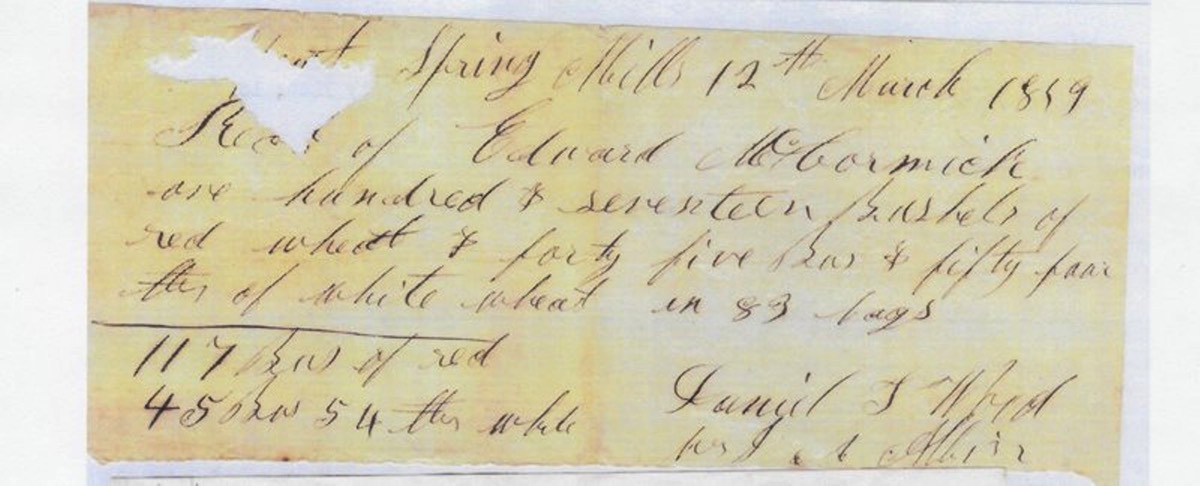
Photo: Spout Spring Mill, 12th March 1859. Received of Edward McCormick one hundred & seventeen bushels of red wheat & forty five bushels & fifty four lbs of white wheat in 83 bags . . . One of seven receipts in the Clermont Archives from Feb. 28 through March 12, 1859, for a total of 1,280 bushels of white and red wheat which Clermont's owner Edward McCormick brought by wagon over the Berryville-Winchester Turnpike (Rt. 7) to the Spout Spring Mill, just on the west side of the Opequon Creek, owned by his friend Daniel T. Wood, who signed the receipt. For this crop various of Edward McCormick's enslaved laborers (28) would have plowed in August 1857, sowed the seed wheat that September-October, and then harvested in late June or early July 1858. As time permitted over that fall and winter, they would have threshed the wheat and shoveled it into 2-lb bags. In late winter 1859, before spring planting, they would have loaded the wagons for the trip to the Spout Spring Mill, which ground the wheat into flour. The mill is now under the west-bound lane of Rt. 7, but Daniel Wood's big red-brick house still stands next door on the hill beside the east-bound lane, next to the Frederick County Wastewater Treatment Plant. It was in front of this house, as Gen. Phillip Sheridan's Union forces crossed the Opequon from Berryville headed to Winchester, that the battle of Third Winchester, the largest battle of the Civil War in the Shenandoah Valley, began on September 19, 1864. It ended with a big Union victory. Two months later, President Lincoln was re-elected partly on its strength, and eight months later, Confederate Maj. Edward McCormick's world changed utterly with Lee's surrender. He came back to Clermont, but the people he had enslaved were gone and a new era had started.
The Clermont Foundation's archives contain many different types of records, but this receipt is an important reminder and illustration that at bottom the farm was a business enterprise. It was not self-sufficient but part of a bigger story. From the beginning, it depended on much larger systems of commodity processors, financing, international markets, and transport routes/haulage to international ports (Alexandria, Baltimore, Philadelphia). And, for almost half its history, the farm's success depended on the use of enslaved labor, which required participation in the maintenance of that enormous system through the buying, selling, and control of people.
ARCHIVES AT CLERMONT
The archives of The Clermont Foundation include both period documents and research related to Clermont Farm since it was surveyed out of the Fairfax proprietary in 1750, the bulk being related to the period of ownership by the McCormick-Williams family from 1819-2004. A body of archived documents and exhibits is being developed for this section of the Foundation's website, starting with the most recent research about the site.
These include a set of nine "Forum Papers" by Virginia historians commissioned by the Foundation, and written for and delivered at a Clermont Forum organized by Prof. Warren R. Hofstra of Shenandoah University in June, 2011. The themes chosen for the papers included Architecture, Agriculture, African American life, Women's' lives, Legal and Medical history, Military history, and Community/Public history at Clermont, which entered public ownership in 2004 by the Commonwealth of Virginia (Department of Historic Resources) and became formally designated as an "historic site" at that time. These papers are rich in detail about the history of Clermont and those who lived there, including those who over 110 years were enslaved there.
Also available are the 800-page text and appendices of Clermont's 2013 Historic Structure Report. The nine-chapter text includes a very complete social history (Chap. 2), a Chain of Events 1750-2012 (Chap. 3), and an architectural developmental history (Chap. 5). The fifteen appendices include an extensive bibliography, existing conditions drawings, historic construction drawings, molding and woodwork drawings, historic photo images, paint analysis report, dendrochronology report, a summary of building construction dates related to ownership dates, and more.
Other documents are being updated and will be added. These include the 2005 National Register Nomination Form, which the Clermont Foundation has an NPS grant to update in 2023 based on the results of the 2013 Historic Structure Report and subsequent research. The Contextual descriptions for the nine periods in Clermont's history listed under "History At Clermont" on this website are also being updated and will be found here, as well as reachable from the History section. With the digitization of Clermont's family archives we plan to add those in the future, as well as the stories of objects illustrating the cultural history of the site, from both above and below ground.
Archives of specific sites are often as notable for what's missing as for what's present. In Clermont's case, all the records pertaining to the ownership by the McCormick family of enslaved Africans were deliberately destroyed by a member of the family in the late 1950's. References to individuals in a few family letters, some receipts (three coffins for children, some shoes), and some public records have begun to reveal a part of their stories.
